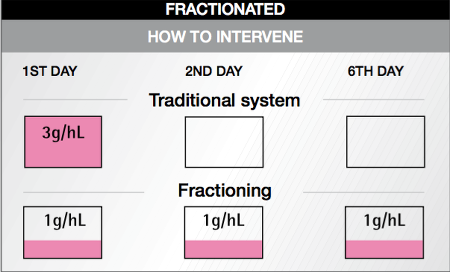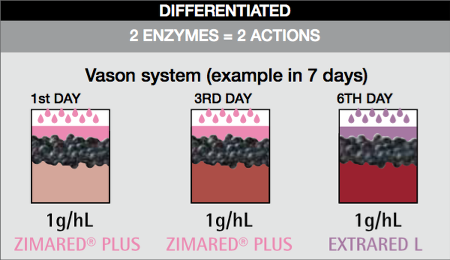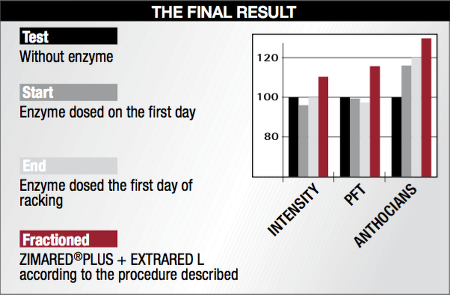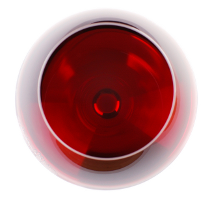Enzymes are organic catalysts of a proteic nature whose job is to accelerate (catalyse) chemical reactions that bring about the formation or breakage of chemical bounds.
Ont of the most important properties of enzymes is their capacity to react in a highly selective manner with one substance (substrate) or on a group of similar substances. This
allow them to act in a targeted manner, chosen according to necessity, for the most ideal commercial application.
Pectins are among the most prevalent colloids in both must and wine. These substances have an elevated solvation capacity and thus increase the solubility of other substances
including salts (sodium bitartrate), proteins, etc. Thus, pectins impede both stabilization and clarification. Moreover, pectins tend to gelatinize relatively easily ans are
therefore an impediment towards filtration.
The enzymatic preparations from Enologica Vason all have an elevated pectolytic activity that provides, depending on the product, a series of secondary enzymatic activities,
including proteolytic, cellulolytic, hemicellulolytic, glycolytic, etc.
These enzymes are always obtained by production processes that guarantee the final product to be virtually free of undesirable secondary activities (polyphenoloxidases,
cinnamylesterase, anthocyanase, pectin-methyltransferase) and do not require any additional purification steps.
| Enzyme |
Form |
Activity |
Applications |
Oenological effects |
Doses |
BACTOZYM® SPECIAL GRAINBACTOZYM® SPECIAL GRAIN : On white and red wines, to control the bacterial activity
(avoiding malolacticity and lactic acescence) without using excessive amounts
of sulfur dioxide.
Can also be used for secondary fermentation of petillant and sparkling wines and for the preparation of an uncontaminated starter. |
Granulated |
Lysosime |
Enzyme preparation to control Malolactic Fermentation |
Inhibits the growth of lactic bacteria (type Oenococcus, Lactobacillus, Pediococcus) |
from 20 to 50g/hl |
EXTRARED LEXTRARED L: Liquid pectolytic enzyme with extracting and stabilizing activity.
Improve the extraction of polysaccharide
compounds during the last phases of maceration which allows skin cell
walls to break down and colors to be extracted. |
Liquid |
Pectolytic Cellulase
Hemicellulase
Protease |
Vinification of red wines: for the extraction and stabilization of coloring substances |
Stable color
Increases organoleptic balance |
1-2g/hl |
FLOTTOZIMA® POWDER OR LIQUIDFLOTTOZIMA® POWDER OR LIQUID: Pool of enzymes in powder or liquid form with high pectolytic activity:
- to reduce the viscosity of the product ;
- to facilitate the flotation process.
The liquid form is able to obtain a rapid separation of
the pomace (in the case of especially difficult products). |
Liquid or powder |
Pectolytic |
Flottation - For settling juice hard to clarify |
Aromatic cleaness and decrease of herbacious caracters |
from 0.5 to 5g/hl |
MANNOZYM®MANNOZYM®: Enzyme preparation of Betaglucanases with lysogenic activity. For the treatment of wines made from
botrytized grapes.
Its remarkable lysogenic action increases the presence of the cellular yeast constituents, especially mannoproteins, in the wine.
These macromolecules give the wine a better sensation of fullness and show a high stabilizing effect on proteins and potassium bitartrate. |
Powder |
Betaglucanases |
Treating wines from Botrytis affected grapes, on the wine to increase the rate of lees extraction. |
Improves filterability ; increase mouthfeel ; better and fast extraction of mannoproteins on "sur lies" |
from 0.5 to 4g/hl |
ZIMACLAR®ZIMACLAR®: Enzyme preparation with high pectolytic activity
Its use permits to:
- reduce the viscosity of the product;
- obtain a rapid separation of the pomace ;
- obtain an optimal
compaction of the lees ;
- increase the yield of flower must improve filterability considerably. |
Powder |
Pectolytic |
For the clarification of white must and young wines |
Increase must yield ; increased filtration capacity |
from 1 to 3g/hl for 2 hours at 20°C |
ZIMACLAR® PH3ZIMACLAR® PH3 : Enzyme preparation for the clarification of white must and young wines.
To improve clarification of musts and product filterability in all the vinification processes.
To increase
yealds during pressing.
To be used on musts coming from early vintaes, on musts for sparkling wines or on musts with
low pH levels. |
Powder |
Pectolytic |
Must at low pH (white, rosé and sparkling wines) |
Improves clarification for musts from early vintage with low pH. Increases yeald during crush maceration. |
from 1 to 3g/hl |
ZIMAFRUITZIMAFRUIT : Enzyme preparation for extraction and liberation from grape skins of varietal aromatic components and for clarification.
Studied for the production of full-bodied wines from an aromatic varietal point of view, and to improve the clarification of
musts.
It is possible to use ZIMAFRUIT directly on the grapes or during maceration, in contact with the skins. Its use in white
and red vinification is interesting for the extraction of varietal and fruity notes. |
Powder |
Pectolytic
Glycosidase |
Maceration of white, red and rosé must |
Increase fruit ; aromatic precursors ; more stable and intense color |
white wines: de 1 à 2g/hl
red and rosé wines : 2g/hl |
ZIMARED® PLUSZIMARED® PLUS :
Pool of enzymes for vinification in red.
During maceration processes for red wines, to:
- anticipate the extraction of anthocyanins ;
- promote the extraction of
tannic polyphenols ;
- reduce contact time and the number of stirrings and pump-overs ;
- improve filtration and
clarification operations ;
- increase the yield of flower must. |
Powder |
Pectolytic
Hemicellulase
Protease
Polygalacturonase
Pectine lyase |
Maceration of red musts |
Increases yield in must ; extraction of tannic polyphenols ; extaction of anthocyanins ; increases olfactory sensory intensity. |
from 1 to 4g/hl |
ZIMAROM®ZIMAROM® : Enzyme preparation for clarification of aromatic must.
To reduce the viscosity of the product, facilitate separation and compaction of the lees, and increase the yield of flower
must.
To increase of the primary aromatic components of the grape variety.
For clarification: same specifications as
ZIMACLAR®. |
Powder |
Pectolytic
Polygalacturonase
Pectine lyase
Glycosidase |
For white, red and rosé wines |
Increases the terpens concentration, improve the organoleptic profile. |
from 1 to 3g/hl |
ZIMASKIN®ZIMASKIN®: Enzyme Preparation for the vinification of white grapes through maceration.
In the production of white wines through maceration with the pomace (cryomaceration and maceration on skins), to:
- increase
specifically the extraction of aromatic precursors ;
- reduce the viscosity of the must ;
- reduce the time of contact between
the skins and the must ;
- improve filtration and clarification operations. |
Poudre |
Pectolytic
Polygalacturonase
Pectine lyase
| For white must, skin maceration, strong activity to breaks cell membrane |
Increases the aromatic precursors ; Reduces viscosity ; Improves filtration and clarification |
from 1 to 5g/hl on crushed and destemmed grapes (most active between 10°C and 30°C) |




